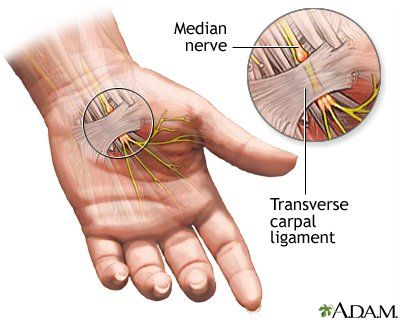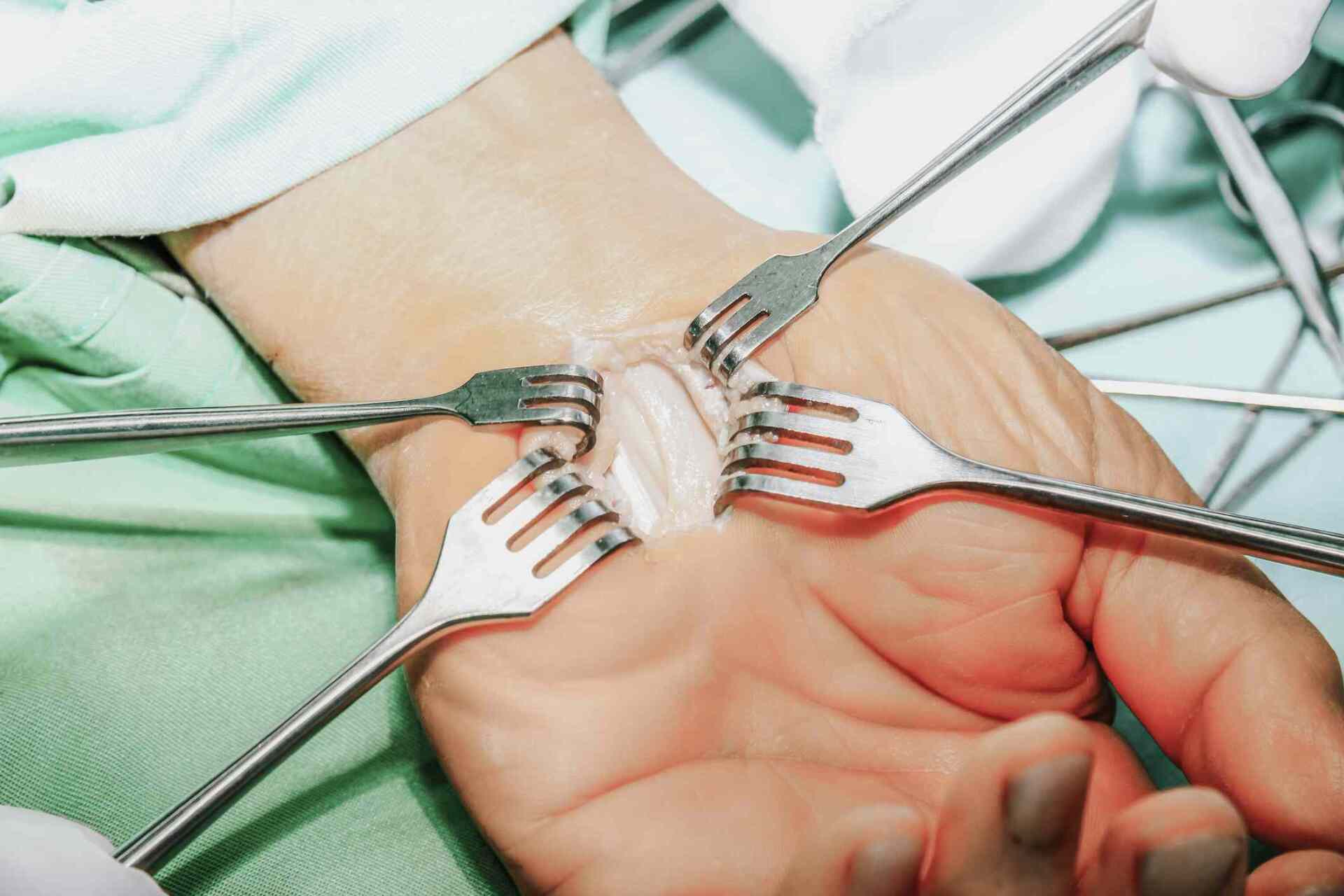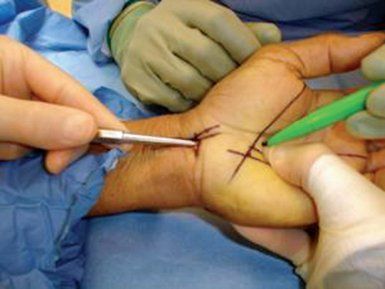Guide to Carpal Tunnel Release Surgery
From Dr. Z - Carpal tunnel syndrome specialist
Carpal Tunnel Release Surgery
It’s a scary thing to think about: someday you might need carpal tunnel release surgery. A hand surgeon may recommend this operation if you have severe carpal tunnel syndrome.
Of course, nobody
wants hand surgery. But sometimes it’s necessary to relieve pain and other symptoms when non-surgical methods failed.
Most patients only have a sketchy idea of what carpal tunnel release surgery is all about - and what to expect. So I’m happy to shed light on what happens. Here's a straight forward and easy-to-understand description.
- FIND OUT: do you have carpal tunnel? No strings attached self-test.
Criteria for having carpal tunnel release surgery
Carpal tunnel syndrome is the most common hand disorder (after arthritis) in the United States today. So it’s no wonder that carpal tunnel release surgery is the fourth most common operation. A doctor will recommend this surgery when you meet the following two criteria:
1. Failure of non-surgical therapies
Non-operative or "non-surgical" therapies can usually treat carpal tunnel syndrome very effectively. The chief ones are rest, stretching exercises and myofascial release massage. Over 90% of patients usually get complete (or near-complete) relief using these remedies.
2. Prolonged & severe symptoms
In about half of patients, pain, numbness or tingling will go away by itself with little or no therapy. This usually happens within 1 month after symptoms first appear. In the other half, once symptoms persist for 6 months they will likely stay. In most of those patients, severe symptoms will ensue.
Therefore, if all non-surgical therapies failed, and you've had persistent severe symptoms for more than 6 months, then you might be a candidate for carpal tunnel release surgery.
Types of carpal tunnel release surgery
Sometimes symptoms just don’t go away. So if all non-surgical remedies failed AND the severe symptoms lasted for over 6 months, your carpal tunnel doctor may recommend hand surgery.
There are two basic types or "procedures" used for carpal tunnel release surgery:
- Open carpal tunnel release surgery
- Endoscopic carpal tunnel release surgery (consisting of single portal or double portal methods)
Both types involve cutting the transverse carpal ligament in the hand. This ligament holds part of the wrist bones together. After cutting the ligament, the wrist joint snaps apart. This releases pressure on the median nerve below. Hence the term “release” surgery.
How much does carpal tunnel surgery cost in your state? Click here to find out.
The types of surgery relate to the basic ways to cut that ligament. One way ("open" method) is to slice the palm open to expose the ligament. Another way is to insert a thin tube into the wrist ("endoscopic" method) to do the same thing.
Usually, patients having the "open" technique will also have general anesthesia, where you're put to sleep. In contrast, about half of "endoscopic" patients are wide awake during the procedure. But their hand and arm are numbed with an anesthetic injection.
We'll discuss more details about open and endoscopic carpal tunnel release surgery below.
Open Carpal Tunnel Release Surgery
The operation is called “open” because the doctor opens the skin over the palm to see the entire ligament. It's currently the most common procedure used to relieve carpal tunnel syndrome - and the safest.
The surgeon will first numb the wrist with a shot. Some doctors inject the numbing drug directly into the palm while others inject it into a bundle of nerves near the collarbone. You also might have a tourniquet around your arm to lessen hand and wrist bleeding. Most times during the open technique, you'll be under general anesthesia.
When the patient is asleep and the arm is anesthetized, the surgeon makes a 2-3 inch-long incision in the palm. It starts in the middle of the palm and sometimes extends into the wrist. Some surgeons will use a "mini-cut" about 1 inch long to avoid excessive scar tenderness later on.
Through the skin opening, the doctor can clearly see the ligament below. The ligament is then snipped in half. As a result, the wrist bones snap apart.
This creates more space inside the wrist joint. That means there's more room for the median nerve, which is no longer squeezed and compressed. It's that squeezing on the nerve that gave you all the problems to begin with.
The surgeon normally performs open release surgery on an outpatient basis. Sometimes, the surgeon might plan a longer operation, which he or she should discuss with you. The entire operation usually takes 30-45 minutes.
Open carpal tunnel release surgery is considered a bit safer than the endoscopic technique. That's because the surgeon can clearly see all of the structures inside. That means there's less chance of accidentally nicking or damaging a nerve or blood vessel.
The downside is that there's more trauma to the hand due to the large incision. That means more post-surgical pain and more hand therapy and rehab later on.
Endoscopic Carpal Tunnel Release Surgery
With endoscopic carpal tunnel release surgery, there are two sub-types:
- Double portal endoscopic carpal tunnel release surgery
- Single portal endoscopic carpal tunnel release surgery
With either of these techniques, there is not as much skin trauma involved compared to the open technique. That results in a quicker recovery after the operation. Also, your aftercare is not as complicated. In addition, you have a smaller scar and therefore less tenderness.
The main disadvantage of endoscopic carpal tunnel release surgery is that sometimes the surgeon cannot see area as well as with the open technique. Therefore, there’s a greater chance of cutting a nerve, blood vessel or developing other complications.
Double portal
This form of endoscopic surgery requires two small holes. One is made in the palm and one in the wrist. The surgeon inserts an endoscope (a camera) into one hole and instruments into the other hole. Then the doctor cuts the ligament. This is the more common endoscopic technique.
Single Portal
Single portal carpal tunnel release surgery works almost the same as the double portal method. The main difference is that the surgeon makes only one hole in the palm. The doctor pokes all instruments including the camera through the single hole. Then the doctor cuts the ligament.
The main advantage with only one hole means healing and recovery happen faster. But the big disadvantage is that it requires much more skill. Therefore not many surgeons use this technique. Also, the cost of this surgery is greater.
Recovery & results of carpal tunnel release surgery
The recovery time and the time you must take off work depend on many factors. Recovery usually takes longer if:
- Surgery was on your dominant hand.
- Open carpal tunnel release surgery was performed.
- Your occupation requires a lot of hand activity.
- Your overall health is poor or you have a chronic disease (like diabetes).
- You're a smoker.
Most people take 1-2 months off work after open release surgery. Compare that with 7-10 days for endoscopic surgery.
In general, open release surgery needs more post-surgical therapy and rehab than either type of endoscopic procedure. But in every patient, it takes a commitment to hand therapy to recover good hand strength. And that can take many months or even years.
The results of carpal tunnel release surgery (no matter the technique used) breaks down as follows:
- About a third of patient who have surgery see symptoms disappear right away. But full recovery can take many months.
- Another
third can take several months to see relief.
- An unfortunate third do not see a difference in symptoms at all. About half of them even see symptoms get worse.
Particularly with the open release technique, the scar may feel tender for up to one year. Loss of grip and pinch strength happens right after surgery, whichever procedure is used. But it usually recovers within a few months after the surgery.
Other facts about carpal tunnel release surgery
It’s important to know that 80% of patients who have carpal tunnel release surgery never return to their original occupation. This is especially true if the work involves a lot of manual labor.
- There are certain risks with carpal tunnel release surgery.
- About 1-4% of patients may have infection or nerve damage.
- Another 6-11% may have abnormal pain or stiffness at the scar.
- Most patients permanently lose some wrist strength, even with therapy.
- For most patients, work responsibilities need changing (if they don't change jobs).
- Carpal tunnel symptoms reappear in about 30% of patients after surgery.
Finally, about 50-70% of patients are satisfied with their carpal tunnel surgery by two years. But another 30-50% are not satisfied. In fact, over 90% of surgical patients still have persistent symptoms.
Sometimes the surgeon advises these patients have another carpal tunnel release surgery. But the success of such a revision surgery is less than 20%.
Conclusion
You will have one of the basic types of carpal tunnel release surgery: open or endoscopic. Deciding on which one you get is completely up to your doctor. That’s because the doctor has experience with one or the other technique. Ask the doctor which procedure you'll have. The choice makes a world of difference in your recovery time.











